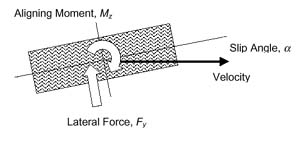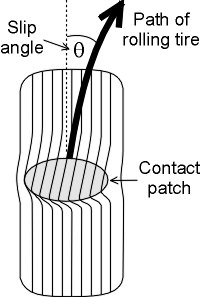Slip Angle
This sounds odd - you might expect that the tyre tread would point in the same direction as the wheel wouldn't you? It doesn't because being made of rubber, the tyre sidewalls deform, and the tread pattern itself can 'squirm' when the wheel is turned from the straight-ahead.
In fact, modest slip angles are 'good' as tyres generate progressively more grip with increasing slip angles (figure 2, opposite), albeit up to definable limit where after no further grip is generated. Thereafter, increasing slip angles are 'bad', and the tyre will tend to loose grip.
Therefore, it should be apparent that if the slip angles for the front and rear tyres are the same (the tyres front and rear are generating similar levels of grip), the car will steer essentially as if there was no slip angle at all (neutral cornering).
Figure 1. Definition of slip angle. Note how the contact patch of the tyre need not be in the same orientation as the whole wheel, often lagging a few degrees behind.


You will recall that a slip angle results from a combination of tyre sidewall flex and tyre traction. Note that if there is no traction (on ice, for example), then the slip angle will become essentially zero. On the other hand, if a wheel travels in a direction other than the one its contact patch is pointing, then you have a SLIDE angle rather than a slip angle.
Slide angles and slip angles are VERY DIFFERENT. Inertia determines the direction the car will travel if it slides (centripetal force). If you lose traction you will slide in the direction you were travelling at the time the slide starts. So long as you have traction you will travel in the direction the contact patch points, not the tyre. Slide angle is the angular difference between the direction inertia sends you and the direction your tyres are pointing while slip angle is the angular difference between the direction your contact patch is pointed (thus, the direction the tyre moves) and the direction the tyre is pointed.
Decreased traction reduces slip angles and increases slide angles!

Acceleration and braking affect traction primarily because of
weight transfer and toe-angle changes.The greater camber, the greater the camber thrust. Camber thrust attempts to turn your wheel into a turn in the direction of lean. Thus, greater camber thrust yields smaller slip angles.
Given that the rear camber of the MGF is greater than the front, you should expect that the rear tyres are almost always operating with a lower slip angle than the front tyres. (I.e., your car tends to under-steer.)
What changes a slip angle into a slide angle? Excessive slip angles!!! That is, a slip angle is so called because the part of the contact patch that is to the outside of your turn is moving faster than the wheel itself is in the direction it (the contact patch) is pointing while the part on the inside is moving more slowly. (Exactly like camber thrust.) Since the outside part is moving faster than the tyre it must be slipping. The inside part is gripping better than it would if moving in a straight line. For this reason the contact patch 'walks' itself into the turn.
The greater the slip angle, the larger portion of the contact patch that is slipping. At some point there is so little part of the contact patch that is not slipping that traction is lost and the tyre begins to slide. Until shortly before then, slide traction increases. Note, however, that traction is generally not lost all at once. Rather than an abrupt loss of traction, it tends to be lost gradually. (Thankfully!!!)
http://autozine.kyul.net/technical_school/handling/tech_handling_4.htm